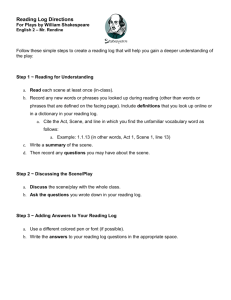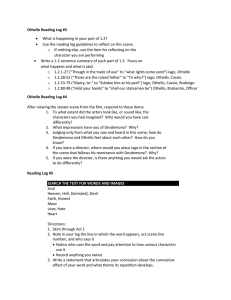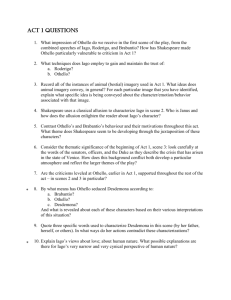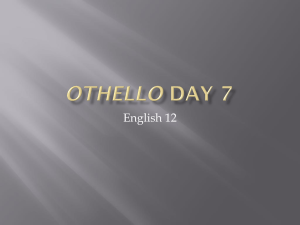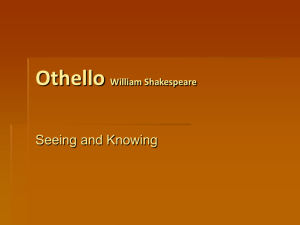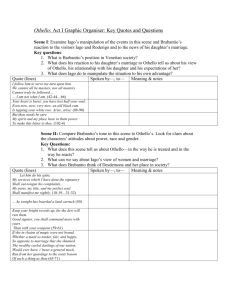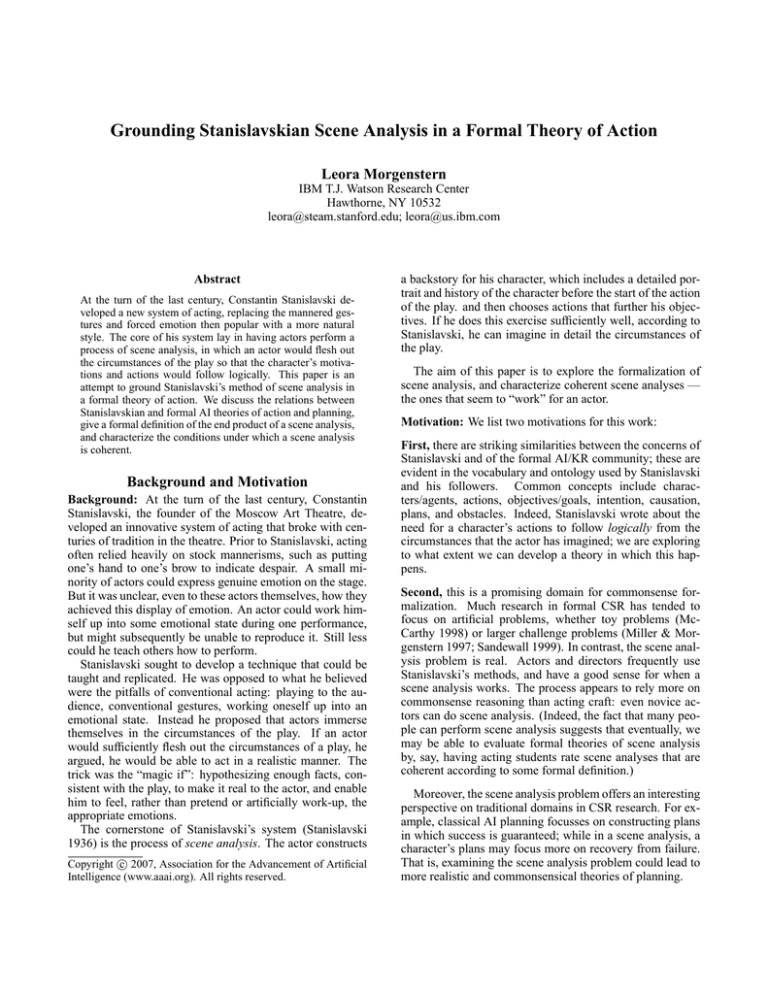
Grounding Stanislavskian Scene Analysis in a Formal Theory of Action
Leora Morgenstern
IBM T.J. Watson Research Center
Hawthorne, NY 10532
leora@steam.stanford.edu; leora@us.ibm.com
Abstract
At the turn of the last century, Constantin Stanislavski developed a new system of acting, replacing the mannered gestures and forced emotion then popular with a more natural
style. The core of his system lay in having actors perform a
process of scene analysis, in which an actor would flesh out
the circumstances of the play so that the character’s motivations and actions would follow logically. This paper is an
attempt to ground Stanislavski’s method of scene analysis in
a formal theory of action. We discuss the relations between
Stanislavskian and formal AI theories of action and planning,
give a formal definition of the end product of a scene analysis,
and characterize the conditions under which a scene analysis
is coherent.
Background and Motivation
Background: At the turn of the last century, Constantin
Stanislavski, the founder of the Moscow Art Theatre, developed an innovative system of acting that broke with centuries of tradition in the theatre. Prior to Stanislavski, acting
often relied heavily on stock mannerisms, such as putting
one’s hand to one’s brow to indicate despair. A small minority of actors could express genuine emotion on the stage.
But it was unclear, even to these actors themselves, how they
achieved this display of emotion. An actor could work himself up into some emotional state during one performance,
but might subsequently be unable to reproduce it. Still less
could he teach others how to perform.
Stanislavski sought to develop a technique that could be
taught and replicated. He was opposed to what he believed
were the pitfalls of conventional acting: playing to the audience, conventional gestures, working oneself up into an
emotional state. Instead he proposed that actors immerse
themselves in the circumstances of the play. If an actor
would sufficiently flesh out the circumstances of a play, he
argued, he would be able to act in a realistic manner. The
trick was the “magic if”: hypothesizing enough facts, consistent with the play, to make it real to the actor, and enable
him to feel, rather than pretend or artificially work-up, the
appropriate emotions.
The cornerstone of Stanislavski’s system (Stanislavski
1936) is the process of scene analysis. The actor constructs
c 2007, Association for the Advancement of Artificial
Copyright Intelligence (www.aaai.org). All rights reserved.
a backstory for his character, which includes a detailed portrait and history of the character before the start of the action
of the play. and then chooses actions that further his objectives. If he does this exercise sufficiently well, according to
Stanislavski, he can imagine in detail the circumstances of
the play.
The aim of this paper is to explore the formalization of
scene analysis, and characterize coherent scene analyses —
the ones that seem to “work” for an actor.
Motivation: We list two motivations for this work:
First, there are striking similarities between the concerns of
Stanislavski and of the formal AI/KR community; these are
evident in the vocabulary and ontology used by Stanislavski
and his followers. Common concepts include characters/agents, actions, objectives/goals, intention, causation,
plans, and obstacles. Indeed, Stanislavski wrote about the
need for a character’s actions to follow logically from the
circumstances that the actor has imagined; we are exploring
to what extent we can develop a theory in which this happens.
Second, this is a promising domain for commonsense formalization. Much research in formal CSR has tended to
focus on artificial problems, whether toy problems (McCarthy 1998) or larger challenge problems (Miller & Morgenstern 1997; Sandewall 1999). In contrast, the scene analysis problem is real. Actors and directors frequently use
Stanislavski’s methods, and have a good sense for when a
scene analysis works. The process appears to rely more on
commonsense reasoning than acting craft: even novice actors can do scene analysis. (Indeed, the fact that many people can perform scene analysis suggests that eventually, we
may be able to evaluate formal theories of scene analysis
by, say, having acting students rate scene analyses that are
coherent according to some formal definition.)
Moreover, the scene analysis problem offers an interesting
perspective on traditional domains in CSR research. For example, classical AI planning focusses on constructing plans
in which success is guaranteed; while in a scene analysis, a
character’s plans may focus more on recovery from failure.
That is, examining the scene analysis problem could lead to
more realistic and commonsensical theories of planning.
The Scene Analysis Process
Example of scene analysis
There are many variations of the scene analysis process
(SAP). We use here a modification of (Gewirtz 2005), itself based on (Lewis 1991) and (Hagen & Frankel 1973).
The examples here refer to Stanislavski’s production plan
for Othello (Stanislavski 1983). We focus on the first scene,
which begins with Iago’s urging Roderigo, who has unsuccessfully pursued the Venetian lady Desdemona, to tell her
father, Brabantio, of her elopement with Othello.
The SAP includes the following steps:
1. Writing a backstory for one’s character, including the personality traits of the character, and the actions that have happened prior to the start of the play
2. Determining a character’s scene objectives
3. Determining which strategies the character uses to
achieve his objectives, and the actions that each strategy
comprises
4. Identifying the obstacles that stand in the way of the character executing his strategies
5. Choosing the strategies and actions that a character uses
to overcome the obstacles.
For example, an actor playing Iago could do an (informal)
scene analysis containing the following:
Iago’s objective throughout the play: Avenging himself on
Othello.
Iago’s scene objective in the first scene: Breaking up Othello and Desdemona’s marriage.
Strategy: Get Roderigo to inform Brabantio of the elopement so that Brabantio will ask officials to annul the marriage.
Obstacles: Roderigo is angry at Iago, doesn’t trust Iago’s
judgement, and doesn’t want to help him.
Strategy to get around obstacles: Appease Roderigo; convince Roderigo of his (Iago’s) trustworthiness; remind
Roderigo of how he has also been hurt by Othello; persuade
Roderigo that informing Brabantio will indeed result in the
desired outcome.
The actor could construct a backstory explaining why
Roderigo is angry at Iago and doesn’t trust his judgement. Stanislavski’s extensive backstory recounts a growing friendship between Iago and Roderigo: Iago defends Roderigo from being beaten up by thugs who mock
Roderigo for his pursuit of Desdemona; Iago offers to help
Roderigo win Desdemona’s hand; Iago asks Roderigo for a
good deal of money in this pursuit; but at the start of the
scene, Roderigo has discovered that Desdemona has eloped
with someone else.
Scene analysis vs. classical AI planning
There are clear similarities between the planning implicit in
scene analysis and classical AI planning. Nevertheless, there
are some important differences:
First, the term action is used differently in the two contexts.
In Stanislavskian scene analysis (SSA), when one refers to
an action, one generally refers to a dramatic action, in the
sense to be explained below. One can, e.g., refer to the (dramatic) actions of killing, convincing, or stealing. But there
are many classical AI actions that are not considered actions
in SSA. For example, Roderigo’s utterance to Iago — “By
heaven, I rather would have been his hangman” — is not
considered an action. When Roderigo says these lines, he
might be rejecting Iago’s explanation, or sympathizing with
Iago, depending on the actor’s scene analysis. Rejecting an
explanation or sympathizing are (dramatic) actions. The utterance of a line itself, however, is never an action. Similarly, movements across the stage (entrances, exits, crossing
the stage) are not considered actions in SSA.
We can divide actions into 3 groups:
1.locutionary actions: the utterances (from the script) that
the character speaks;
2. blocking actions: the movements that the character
makes while on stage; 1
3. dramatic actions: the essential actions that move a play
forward and move each character toward his objectives. Examples: Iago’s convincing Roderigo to ally himself with
Iago, and Roderigo informing Brabantio of the elopement.
The SAP is primarily concerned with dramatic actions.
Instances of locutionary and blocking actions may be coextensional with instances of dramatic actions: i.e., one may
perform a dramatic action by performing (in the sense of
(Goldman 1970)) a locutionary and/or blocking action. For
example, A might perform the action of consoling B by
placing his arms around B (a blocking action) and uttering
“there, there” (a locutionary action). An analysis of the relationship between locutionary and/or blocking actions, on
the one hand, and dramatic actions on the other, is a very
difficult problem and beyond the scope of this paper.
Indeed, analyzing the relationship between locutionary
and dramatic actions — determining what is really happening when a character utters a line — is at least as difficult as
the general story understanding problem. It is in fact more
difficult because a story provides clues about tone and affect
(“he said angrily”) that are often absent in a script. The problem is still harder when one reasons about blocking actions.
E.g., the dramatic action associated with the locutionary action of A uttering “there, there” to B can vary depending on
whether the accompanying blocking action is A putting his
arms around B or A casually tossing a box of tissues to B.
Second, the focus on planning is different. AI planning focusses on constructing a plan which is guaranteed to achieve
the desired result. There is no such guarantee when characters construct plans; indeed, plays would be of limited interest if characters’ plans always succeeded. Rather, a character does his best to choose actions which he believes will
help him pursue his objectives, and replans as necessary.
Consider, e.g., Iago’s objective to break up Othello
and Desdemona’s elopement. His strategy is to convince
Roderigo to inform Brabantio, so that Brabantio will appeal to Venetian authorities to annul the marriage. Iago
knows that a precondition of convincing Roderigo is having
1
Blocking actions will be ignored in the rest of this paper. Directors generally tell actors to cross out all blocking-action stage directions before starting the SAP. Instead, blocking ought to follow
naturally from one’s dramatic actions, which vary with the director
and actors of a particular production.
Roderigo favorably disposed toward him. He knows that if
Brabantio would turn out to be unmoved by the elopement,
then his strategy would fail. In fact, he knows when his strategy fails (for another reason, when the duke refuses to annul
the marriage.) And he replans, choosing another strategy
(making Othello insanely jealous of Desdemona) that will
achieve his larger scene objective, namely, avenging himself
on Othello.
Third, we note that in the AI planning community, there
are two ways to represent goals, as states that the planning
agent tries to achieve, and as tasks that the agent wishes to
accomplish (Sacerdoti 1977; Charniak & McDermott 1985).
The first approach is far more popular in the AI literature. In
contrast, in SAP, an objective is typically spoken of as a verb
or action: e.g., Iago’s objectives are to avenge himself on
Othello andbreak up Othello’s and Desdemona’s marriage.
We find it awkward, however, to represent scene objectives
as dramatic actions/tasks. Rather, it is more useful to identify objectives with goal states, but to allow natural language
descriptions of objectives to be verb-based when this facilitates discussion. We use simple tricks to turn objectives that
are more naturally associated with verbs into states: e.g.,
Roderigo’s objective to marry Desdemona is represented as
the state in which Roderigo is married to Desdemona.
A Formal Theory of Scene Analysis
Notation: The logic is sorted; all variables are universally
quantified unless otherwise indicated. A list of all functions
and predicates used, along with all definitions and axioms,
is available at Appendix B (Morgenstern 2007).
Theory of Action
Our language is based on (Davis 2004). We use a situationbased branching theory of time. Intervals are defined by
their starting and ending situations. Fluents are properties
that change over time. Holds(s,f) (Holds([s1,s2],f)) indicates
that fluent f holds over situation s (interval [s1,s2]).
Actions take place over intervals of time.
Occurs(ac,s1,s2) denotes the action ac occurring between s1
and s2. We can also say Occurs(Do(a, act), s1, s2), which
denotes the action of agent (or character) a performing act
between s1 and s2.act denotes an actional, an action which
is not anchored to a particular agent.
The theory of knowledge and belief is based on the
possible-worlds theory of knowledge introduced by (Kripke
1963) and extended by (Moore 1980). B(a,s1,s2) denotes
that situation s2 is indistinguishable to a from s1, given a’s
beliefs.
Expected Effects, Success, and Failure It will be useful
to refer to the preconditions, success conditions, failure conditions, and effects of actions. The preconditions of an action
are those fluents which must be true at the start of an action
in order for an action to be performed. Effects and success
conditions are closely connected to one another: an action
has certain effects — fluents which hold at the end of an action — as long as certain success conditions (fluents) hold
at the beginning of the action. Failure conditions are fluents
which, if they hold at the beginning of an action occurrence,
preclude the effects holding at the end of the action. Note
that if one has a complete description of all success conditions, one can derive the failure conditions. Agents, however, typically don’t have such complete descriptions. Nevertheless, an agent is typically aware of at least some of the
failure conditions for the actions that he intends to perform,
and if he becomes aware that a failure condition holds, may
work to change that fluent’s truth value or choose another
action to perform.
Any action theory in this domain will therefore include
three types of axioms:
Precondition axioms, of the form Occurs(ac, s1, s2) ⇒
Holds(s1, f). f is a precondition of ac.
Effect axioms, of the form (Occurs(ac, s1, s2) ∧
Holds(s1,f1)) ⇒ Holds(s2, f2). f1 is a success condition of
ac, and f2 is the effect.
Failure axioms, of the form (Occurs(ac, s1, s2) ∧ Holds(s2,
f2)) ⇒ ¬ Holds(s1,f1). f1 is a failure condition for ac.
We introduce the following predicates on actions:
• Precond(ac,f): f is a precondition of performing ac
• SuccessCond(ac,f1,f2): f1 is a sufficient condition for the
successful performance of ac, resulting in effect f2
• FailCond(ac,f1,f2): f1 is a sufficient condition for the failure of ac to achieve f2.
The first and third predicates will be useful in stating the
definition of coherence in Section 3.3 and in stating the axioms and developing the proof in Appendix A (Morgenstern
2007).
Objectives and Strategies Objectives: An objective is
represented as a fluent, a state that an agent wants to achieve.
Strategies: Our development of strategies is influenced by
the ideas of (Gordon 2004). A strategy is a relatively loose
structure of actions, much like a partial plan, with the following characteristics:
• It comprises a set of actions, or other strategies, that may
be used to accomplish a particular strategy.
• It may, but does not necessarily, mandate the order in
which these actions/strategies must be performed/executed.
• It does not necessarily contain the complete set of actions
necessary for success.
• Its execution does not guarantee success in achieving one’s
objective.
• It will typically have gaps; there is not an action prescribed
for every time period in which the strategy is executed. (An
agent may execute a second strategy during a gap in the first
strategy.)
• It may include actions performed by other agents. E.g.,
Iago’s strategy for breaking up Othello and Desdemona’s
marriage includes Roderigo’s action of informing Brabantio of Othello and Desdemona’s elopement. (The strategy
will, of course, fail if the other agent does not do his action
in a timely manner.)
• It may include reactive actions — actions that respond to a
particular situation or action of another agent. E.g., (Section
4), a strategy to keep a secret may include the reactive action
of refusing to answer an agent’s question if doing so would
entail the secret becoming known.
Analogous to the concept of an action occurring during an
interval is the notion of a strategy being executed during that
interval. We distinguish between a complete and an incomplete execution. Intuitively, a strategy strat is completely
executed during an interval if all non-conditional actions included in strat occur or, recursively, if all non-conditional
strategies included in strat are executed; if all conditional
actions/strategies occur/are executed if the conditions hold;
and if the order in which these actions occur and strategies
are executed satisfy the temporal constraints. If a strategy is
begun but not concluded (for whatever reason, e.g., if some
action in the strategy is not executed), it is said to be incompletely executed. The predicate Executes(a,strat,f,s1,s2)
denotes that a executes strategy strat in pursuit of objective f between s1 and s2 and that the execution is completed.StartExecute(a,strat,f,s1,s2) denotes that a begins to
execute the strategy strat, and that the execution takes place
between s1 and s2. The execution may not be complete at
s2.
To define a strategy, we first introduce some syntactic sugaring conventions.
• Do(a, Act(~x) | P(~x)) denotes the action of a doing actional
Act with the range restricted to P in the obvious way.
• In general, Occurs(Do(a, Act(~x) | P(~x)), s1,s2)
⇔ ∃x (P(~x) ∧Occurs(Do(a, Act(~x)), s1, s2)).
We call a sentence of the form Occurs(ac,si,sj) or of the
form above, or either of these forms preceded by a negation
sign, an occurrence sentence.
These syntactic sugaring conventions are extended in an
analogous way to the Executes and StartExecute predicates.
We call a sentence of the form Executes(a, strat, f, si,
sj), StartExecute(a, strat, f, si, sj), the syntactically sugared
form, or any of these forms preceded by a negation sign, an
execution sentence.
For an occurrence or execution sentence, the active agent
is defined as the first argument to the Do function or the Execute/ StartExecute predicates; the active interval is defined
as the interval formed by the last two arguments of the Occurs, Execute, or StartExecute predicates.
Strategies, like actions, can be viewed as sets of intervals.
A strategy is of the form {(ss,se) | Σ ∧ κ}, where Σ is a
conjunction of action and strategy occurrence formulas, κ is
a conjunction of temporal constraints, and Σ and κ satisfy
the following:
• Each conjunct of Σ is of the form
Ψ1 (~x) . . . Ψm (~x) ⇒ Φ1 (~x) . . . Φn (~x), where
(a) ~x represents an array of variables, including situational,
action, and agent variables
(b) any of the Ψi or Φi is an occurrence or execution sentence as defined above, or of the form [¬] Holds(s,f) and
(c) at least one of the Φi is an occurrence or execution
sentence.
Each conjunct of κ is of the form si < sj or si ≤ sj , for
some i,j.
Example: {(s1,s4) | Occurs(Do(a1,Act1(x) | P1(x)), s1,s2) ∧ Occurs(Do(a2,Act2(x) | P2(x)), s3,s4) ∧ s2 ≤ s3 }
is an example of a strategy. More examples can be seen in
Appendix A.
Interaction between strategies and objectives
At any situation in time, an agent has at least one primary objective, his scene objective. Strategies are used to
achieve objectives; the pursuit of a strategy may generate
other objectives. As an agent uses a strategy to achieve his
objectives, he may form objectives to achieve preconditions
or avoid failure conditions for the actions in his strategy. In
order to formalize the interaction between strategies and objectives, we need to express how an agent proceeds through
his strategy. The following functions and predicates will facilitate this discussion:
• ActionOf(strat, ac) denotes that ac is one of the actions in
strategy strat.
• Precursor(ac1,ac2,strat) denotes that ac1 must be performed prior to ac2 when strat is executed. (This relation
is entailed by the temporal constraints in a strategy.)
• StrategyFor(f,strat) denotes that strategy strat is a strategy
for pursuing objective f.
• Holds(s,SObj(a,f)) denotes that f is the scene objective of
a in s.
• Holds(s,CObj(a,f)) means that f is a current objective of a
in s. (There may be multiple objectives.)
• Holds(s,CStrat(a,f,strat)) denotes that strat is a’s current
strategy in s in pursuit of his objective f.
• Holds(s, CAction(strat, a1, f, do(a2,act))) denotes that the
action do(a2,act) is a current action for a1’s strategy strat to
achieve objective f. Note that a1 may be distinct from a2.
An action ac is said to be done in s relative to some agent
a and strategy strat if there was some interval, ending in s,
in which strat was the current strategy of a for achieving objective f, and ac occurred at some point during that interval.
Definition of done:
Holds(s, Done(ac,a, strat)) ⇔
ActionOf(ac,strat) ∧
∃ f, ss’, ss, sa, sb Holds([ss,s], CStrat(a,f,strat)) ∧
∀ s’ ss’ ≤ s0 < s ⇒ ¬ Holds(s’,CStrat(a,f,strat)) ∧
sa ≥ ss ∧ sb ≤ s ∧ Occurs(ac, sa, sb)
An actional act is a potential action for an agent a pursuing some strategy strat if all the precursors of ac in strat
have already been done:
Definition of potential action:
Holds(s,PotAct(a,act,strat)) ⇔
∀ ac Precursor(ac,Do(a,act),strat)
⇒ Holds(s,Done(ac,a,strat))
Strategy Failure: The notion of strategy failure is central
to the development of a formal theory of scene analysis.
While an agent is not required to predict the success of his
strategies — indeed, because he has no such requirement —
he needs to realize when his strategies are not working out.
Holds(s, StrategyFailed(a,f,strat)) says that at situation s, the
particular strategy strat that agent a has chosen in his pursuit
of objective f has failed.
Although a complete analysis of strategy failure is beyond
the scope of this paper, we make some observations about
the circumstances in which a strategy may fail:
1. a is pursuing a strategy and has performed an action in
this strategy, but the expected effect does not hold.
2. a is pursuing a strategy, which calls for him to perform an
action. The action has a precondition which does not hold,
and he either does not know or cannot perform an action to
establish that precondition.
3. a is pursuing a strategy, which calls for another agent a’ to
perform an action. a’ performs the action, but the expected
effect does not hold.
4. a is pursuing a strategy, which calls for another agent
a’ to perform an action. a’ does not perform the action, or
performs the contrary of the action.
An example of the fourth type of failure can be seen in
Iago’s strategy to break up Desdemona’s and Othello’s marriage. His strategy consists of his convincing Roderigo to
inform Brabantio of the elopement; for Brabantio to alert
the duke; and for the duke to annul the marriage. However,
the duke does not annul the marriage; in fact, he confirms
that it is valid.
When a strategy fails, an agent may repeat the strategy or
choose another strategy to achieve his objective. E.g., when
Iago’s initial strategy to break up Desdemona and Othello
fails, he chooses another strategy: making Othello jealous
of Desdemona. It is not trivial to characterize in what circumstances an agent will switch strategies or repeat a strategy/action. Certainly, plays — and life — are rife with examples of agents who persist in a strategy and prevail. Iago,
for example, must repeatedly entreat Roderigo before the
latter agrees to inform Brabantio of the elopement. Yet unrestrained persistence is, at best, the stuff of slapstick comedy.
An analysis of strategy persistence vs. strategy switching
might formalize the following: that agents may persist in
a strategy for a certain amount of time, or repeat an action
several times until they reach some threshold of tolerance;
that the threshold that an agent has for repetition may depend
on a variety of factors, including the ease of performing an
action, expected payoff, availability of other strategies, or
difficulty of executing such other strategies. This is left for
future work.
Motivation One wishes not merely to posit an agent’s
scene objective, but to ground this objective. The backstory
can provide this grounding. For example, Stanislavski’s
backstory for Othello (Stanislavski 1983) explains the past
connection between Othello and Iago, detailing occasions
where Iago saved Othello’s life; Iago’s low-born background; Othello’s decision to choose as lieutenant the highborn but unworthy Cassio, because he needs to appear polished in elegant Venetian society. This motivates Iago’s resentment and explains why Iago wants to avenge himself on
Othello.
The notion of motivation used here is significantly weaker
than that, say, of (Stein & Morgenstern 1994) (where an
action was motivated if its occurrence was entailed). This
theory retains the concept of free will: No matter what
has happened, a person is never forced to choose an objective. Rather, we introduce the predicate Motivated(a, f), provide axioms for this predicate, and then show that particular
backstories entail particular instantiations of the Motivated
predicate. Even if an objective is motivated for a particular
character, however, it is not necessarily the character’s scene
(or current) objective.
Scenes and Scene Analysis
We define a scene SC as a tuple < Char, Σ >, where Char
is the set of agents/characters in the scene and Σ is a sequence of (mostly) locutionary actions. (Σ may include dramatic actions that are forced (entailed) by the script. E.g.,
the script of Othello entails that Othello kills Desdemona.
However, in general, most dramatic actions are introduced
during the SAP.)
We define a scene analysis SA(SC, A’) as a tuple <
Char, Σ, [SS,SE], BStory(A’,SS), Obj, ∆(A’,SS,SE), Π >,
where
• Char and Σ are as above
• SS and SE are the starting and ending situations of this instantiation of the scene,
• BStory(A’,SS) is the backstory of character A’ up to situation SS, defined as a set of sentences, each of which is of the
form Holds(s, f) where s ≤ SS, or is an occurrence sentence
whose latest time point is earlier than SS and whose active
agent is in Char
• Obj is a set of fluents, the objectives of A’,
• ∆ is the dramatic history of the scene, defined as a set
of sentences each of which is of the form Holds(s,f) or is
an occurrence/execution sentence whose active agent is in
Char and whose active interval is contained in the interval
[SS,SE]
• Π relates subsets of ∆ to subsets of Σ. That is, Π associates dramatic actions with lines in the script. In general,
one line of the script may be associated with several dramatic actions, and one dramatic action may be associated
with several lines in the script.
Let Γ(SA(SC,A’)) be the union of the sentences in the
backstory and the dramatic history.
Coherence
Our goal is to characterize those scene analyses that make
sense, that “work” for an actor. Informally, we would like to
say that a scene analysis is coherent if the following conditions hold:
[1] The scene objectives are motivated with respect to the
backstory
[2] Any other objectives arise from the original scene objectives, the strategies taken to pursue objectives, and the facts
that are true during the scene
[3] An agent will pursue a strategy only for an objective
[4] An agent’s actions during the scene follow from his objectives and chosen strategies
[5] An agent will not continue a strategy that he believes has
failed.
Definition: Let SC be a scene and SA(SC,A’) a scene analysis for character A’, as defined above. Let Γ(SA(SC,A’)) be
the set of wffs associated with the scene analysis, as defined
above. Let Γ(CSK) be a set of sentences representing
a body of commonsense knowledge. (E.g., for Othello,
this might include commonsense domain theories about
wooing spouses, and fathers’ reactions to their daughters’
elopements.)
Then SA is coherent iff Γ(SA(SC,A’)) ∪ Γ(CSK) |=
1. (motivation of scene objectives)
(∀s ∈ [ss, se] Holds(s,SObj(A’,f)) ⇒ Holds(s, Motivated(A’,f)) ∧
2. (subgeneration of other objectives)
(Holds(s, CObj(A’,f)) ⇒ Holds(s, SObj(a,f)) ∨
∃ strat, ac,f’ (Holds(s,CStrat(A’,f, strat)) ∧ ActionOf(ac,strat) ∧¬ Holds(s, Done(ac,A’, strat)) ∧
(Precond(ac,f) ∨ FailCond(ac,¬f,f’))) ∧
3. (strategy pursuit only for objectives, and only if not
failed)
(Holds(s,CStrat(A’,f, strat)) ⇒
((Holds(s,CObj(A’,f)) ∧ StrategyFor(strat,f) ∨
(Holds(s,CObj(A’,f’) ∧StrategyFor(strat’,f’)
∧StratPart(strat,strat’)) ∧
¬ ( B(A’,s,s’) ⇒ Holds(s’,StrategyFailed(A’,f,strat)))) ∧
4. (actions are performed by A’ only if done as part of some
strategy and only if it is believed that they will not fail)
(occurs(s,s’,do(A’,act)) ⇒
Holds(s,CStrat(A’, f,strat)) ∧
Holds(s,PotAct(A’,act,strat)) ∧
¬∃ f’ (FailCond(Do(A’,act,f,f’) ∧∀s(B(A’,s,s’) ⇒
Holds(s’,f)))
Example
To demonstrate how one can perform a scene analysis and
show that it is coherent, we use a small sample script, used in
teaching principles of scene analysis, adapted from (Kahan
& Rugg 1998).
A: Give me that.
B: No.
A: Give it to me.
B: I don’t think so.
A: Come on: I really want it.
B: No!
(A grabs it from B.)
B: Well?
A: Well what?
B: Well, say something.
A: What do you want me to say?
B: You might have something to say.
A: I’m not going to say anything.
This mini-scene is clearly ambiguous (are the characters
two children arguing in the playground over a toy? a parent
forbidding something to a child?); the point of scene analysis is fleshing it out.
What follows is an overview. (The full analysis is in Appendix A (Morgenstern 2007).) We do the scene analysis
from B’s point of view. First we present the scene analysis: We give the scene (characters and set of locutionary
actions), posit a backstory, B’s objectives, the dramatic history, and the mapping between locutionary actions and the
dramatic history. Then we prove that the scene analysis is
coherent according to the definition in Section 3.3.
We note the following:
• There is no attempt to automate construction of a backstory or dramatic history. The aim is not to automate creative analysis, but to demonstrate that a particular example
of creative analysis is coherent.
• There is no attempt to represent the locutionary actions as
anything beyond Do(a,utter(q)), where q is a string of the
English language. As argued in Section 2.2, demonstrating
the relationship between locutionary actions and dramatic
actions is a very difficult problem and beyond the scope of
this paper.
We highlight the main points of the scene analysis:
The backstory: We posit a backstory where A and B are in
a relationship. B wants to break up with A. B has already
purchased a one-way ticket to the Bahamas. A has just seen
that B is holding something, but doesn’t know what it is. B
is a non-confrontational person.
B’s objective: breaking up with A without having to say to
A’s face that she wishes to break up with him.
B’s strategy is the Runaway strategy. It consists of hiding
her desire to break up with A until she begins her trip, taking
her trip, and then writing a letter to inform A of the breakup.
Hiding something is itself a strategy. It consists of a reactive
action: if Y’s objective is to hide something, and X asks Y
to do something which would entail X’s finding out, then Y
must refuse.
The dramatic history: A asks B to hand him the ticket. B
knows that if she agrees to this request, A will find out that
she has a one-way ticket, and will infer that she is planning
a breakup. To execute the hiding strategy, B must therefore
refuse A’s request. This is repeated three times.
A then grabs B’s ticket. At this point, B’s strategy to hide
her desire to break up with A has failed. Indeed, her Runaway strategy has failed. However, she still has the same
objective: to get out of her relationship with A. She now
switches strategies, to taunt A with the fact that she has a
one-way ticket to the Bahamas. She tries this several times,
but A does not take the bait.
The proof of coherence: The formal proof is simple and
consists mostly of matching definitions. First (condition 1),
we demonstrate that B’s objective is motivated by the backstory. This follows from some commonsense domain axioms on relationships and non-confrontational tendencies.
Next (condition 2), we demonstrate that at any point, all
current objectives of B are scene objectives or are generated
from the scene objectives. Since we only deal with B’s single scene objective, this is trivial.
Next (condition 3), we demonstrate that B pursues her
current strategy only when it lines up with her current objective and only when she knows the strategy hasn’t failed.
Assume that A’s grabbing the ticket occurs between Sa and
Sb. Until Sb, B’s current strategy is the Runaway strategy.
At Sb, B realizes that this strategy has failed, and switches to
the Taunt strategy/action, which still lines up with her current objective.
Next (condition 4), we demonstrate that B performs actions only if they are part of her current strategies. We consider each of B’s 6 actions. Her first 3 actions, which happen
before Sb, are refusing A’s request to hand over the ticket.
These are part of the Hiding strategy, which is itself part of
the Runaway strategy. Her next 3 actions, which happen after Sb, are part of the Taunt strategy/action.
This completes the informal discussion of the proof.
Related Work
There have been two previous studies relating AI and
Stanislavskian theory. El-Nasr (El-Nasr 2004) develops an
interactive narrative architecture, based on certain aspects of
Stanislavskian theory, and uses it for various virtual entertainment applications. She uses a version of a scene analysis ontology as the basis of her application’s data structure.
Hoffman (Hoffman 2006) has considered how one might apply Stanislavskian theory to construct robots that interact
with humans. A primary focus is the physical actions and
gestures that a robot would perform. Neither El-Nasr nor
Hoffman works in formal logic, and neither addresses the
notion of coherence.
There are clear connections between our work and first,
the long tradition, dating back to (Schank & Abelson 1977),
of story understanding using knowledge of an agent’s goals
and plans; and second, the work toward a declarative theory
of reactive planning (Traverso et al. 1996). These lines of
research are less formal than our theory, and do not address
the notion of coherence.
Conclusions and Future Work
We have presented a formal theory of Stanislavskian scene
analysis. Our theory builds upon previous theories of action, but adds several new elements, including concepts of
strategy and strategy failure.
Future work includes first, developing a more detailed
theory of strategy failure, by formalizing the discussion of
section 3; and second, extending the notion of scene analysis to multiple agents. The question arises, when looking at
the scene analyses of different characters in a scene, whether
these scene analyses are consistent, and what level of inconsistency we can tolerate. One character need not be aware
of all the beliefs or even actions of another character, but at
some level, they must share beliefs and knowledge of what
is happening in the scene.
In the long term, we wish to attempt to formalize a
later stage of the SAP: determining which of a character’s
emotions are supported by a scene analysis. We believe that
this requires much preliminary work in developing a formal
structure for representing and reasoning about emotions.
Acknowledgements: I am grateful to Laurence Gewirtz for
guidance and helpful discussions, and to Ernie Davis for his
comments on an earlier draft of this paper.
References
Charniak, E., and McDermott, D. 1985. Introduction to
Artificial Intelligence. Addison Wesley.
Davis, E. 2004. Knowledge and communication: A firstorder theory. Artificial Intelligence 166:81–140.
El-Nasr, M. S. 2004. A user-centric adaptive story architecture: borrowing from acting theories. In Advances in
Computer Entertainment Technology, 109–116. ACM.
Gewirtz, L. 2005. Ten questions actors must consider when
working on roles. unpublished.
Goldman, A. I. 1970. A Theory of Human Action. Englewood Cliffs: Prentice-Hall.
Gordon, A. S. 2004. The representation of planning strategies. Artif. Intell. 153(1-2):287–305.
Hagen, U., and Frankel, H. 1973. Respect for Acting. New
York: Macmillan.
Hoffman, G.
2006.
Acting lessons for artificial
intelligence.
In Proc., 50th anniv. summit of AI
(AI-50). http://web.media.mit.edu/ guy/publications/AI50hoffman.pdf.
Kahan, S., and Rugg, K. W. 1998. Introduction to Acting.
Allyn and Bacon.
Kripke, S. 1963. A semantical analysis of modal logic i:
Normal modal propositional calculi. Zeitschrift fur Mathematische Logic und Grundlagen der Mathematik 9:67–97.
Lewis, R. 1991. Advice to the Players. Theatre Communications Group.
McCarthy, J. L. 1998. Elaboration tolerance. In Working Papers of the Fourth International Symposium on Logical Formalizations of Commonsense Reasoning, Common
Sense 98.
Miller, R., and Morgenstern, L.
1997.
The
commonsense
problem
page.
http://wwwformal.stanford.edu/leora/commonsense.
Moore, R. C. 1980. Reasoning about knowledge and action. SRI Technical Report 191.
Morgenstern, L. 2007. Appendices a and b to grounding
stanislavskian scene analysis in a formal theory of action.
Available at http://www-formal.stanford.edu/leora/st and at
http://www.ucl.ac.uk/commonsense07/papers/notes/morgenstern.
Sacerdoti, E. D. 1977. A Structure for Plans and Behavior.
New York: Elsevier North-Holland.
Sandewall, E.
1999.
Logic Modelling Workshop.
http://www.ida.liu.se/ext/eta/lmw.
Schank, R., and Abelson, R. 1977. Scripts, Plans, Goals,
and Understanding. Lawrence Erlbaum Associates.
Stanislavski, C. 1936. An Actor Prepares. New York:
Routledge.
Stanislavski, C. 1983. From the production plan of othello.
In Cole, T., ed., Acting: A Handbook of the Stanislavski
Method, revised edition. New York: Three Rivers Press.
Stein, L. A., and Morgenstern, L. 1994. Motivated action theory: a formal theory of causal reasoning. Artificial
Intelligence 71(1):1–42.
Traverso, P.; Giunchiglia, E.; Spalazzo, L.; and
Giunchiglia, F. 1996. Formal theories for reactive planning systems. In AAAI’96 Workshop on Theories of Action,
Planning, and Control.

